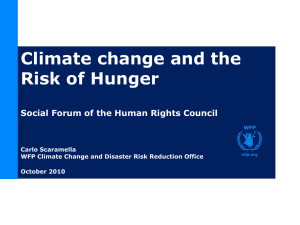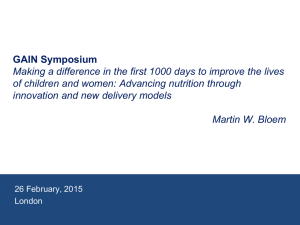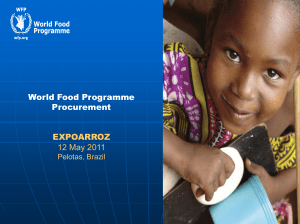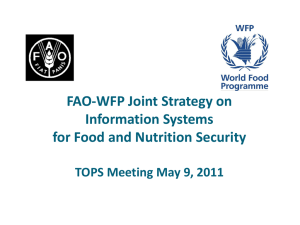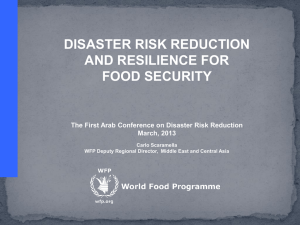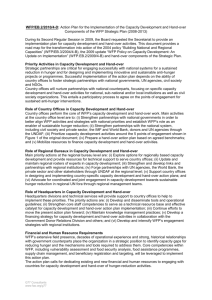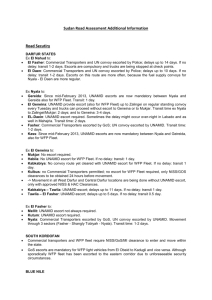Introduction to Market Integration
advertisement
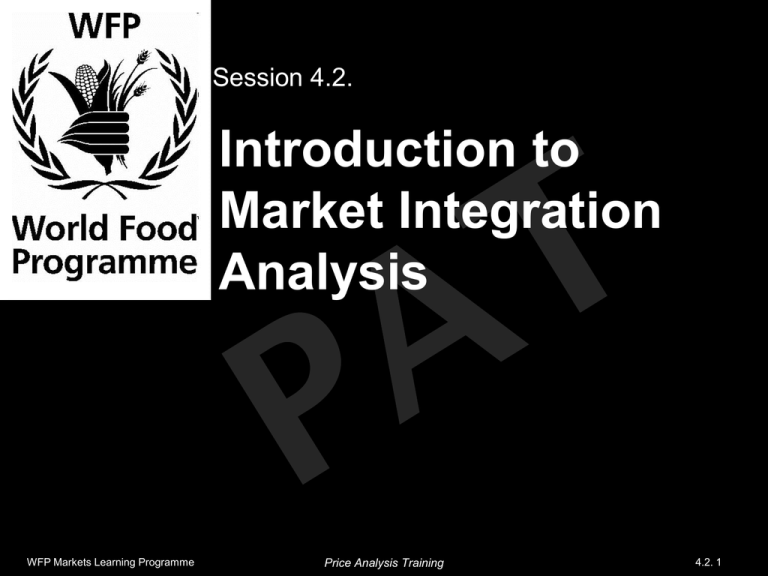
Session 4.2. Introduction to Market Integration Analysis WFP Markets Learning Programme Price Analysis Training 4.2. 1 Learning Objectives By the end of this session, participants should be able to: Explain concept and definition of – and importance of analysing – market integration Explain the possible implications of poorly integrated markets for food insecurity, vulnerable households, and WFP programming/response options including local procurement of food commodities Analyse a graph and determine the degree to which prices move/do not move in tandem across markets to ascertain whether those markets are/are not integrated Calculate average of price differences between markets in a given period WFP Markets Learning Programme Price Analysis Training 4.2. 2 Key Areas of Session Focus Content Markets and Food Security Defining Market Integration Determinants of Market Integration Implications of Market Integration for Food Security Measuring Market Integration WFP Markets Learning Programme Price Analysis Training 4.2. 3 Quick Case: Pakistan Earthquake and Market Integration Task: Read the Quick Case and, with a partner, answer the questions below. Quick Case: Large wholesale markets in Rawalpindi & Islamabad remain well integrated with secondary & tertiary (retail) markets in less affected urban and semi-urban areas. Major issues confronting affected urban populations are food access & lack of cash reserves. Most appropriate response for urban populations with functional & rapidly recovering markets is non-food response. Localized food availability and food access are primary concerns for remote rural populations, where previously well-integrated markets remain temporarily disconnected until roads are reopened, infrastructure is repaired, and credit and supply chains are restored. Replacement of in-kind relief for cash in rural areas after the next harvest when transport corridors reopen and market infrastructure and supply chain linkages are restored should be considered. Little evidence of market recovery or capacity to resume normal market function was observed in Balakot, a severely damaged area. Questions: • According to the case, what is the situation of markets in the larger urban areas? What factors likely account for this? • What is the situation of the more remote, rural markets in the case? What factors likely account for this? WFP Markets Learning Programme Price Analysis Training 4.2.4 Adapted from: Nyberg, Jennifer, “Pakistan Market Assessment – Earthquake Affected Areas”, WFP, 2005. Markets in Food Security Analysis Market integration matters: This is where we see the linkages between availability and access… WFP Markets Learning Programme Price Analysis Training 4.2. 5 Markets in Food Security Analysis Markets A Simplified Framework Markets are more concerned with food availability and access than food utilization Agricultural inputs Extension National food production and stocks Food production Market HH Assets Non-food production Food Availability Food Security Commercial imports Food aid Market Market HH CASH AVAILABILITY Microfinance Employment Market Market Food Access Transfers Remittances Loans WFP Markets Learning Programme Price Analysis Training 1.2. 6 What is Market Integration? The existence of trade flows: the movement of food in response to supply/demand imbalances Market integration allows price signals to be transmitted from one market to another Impact on HH Food Security of market integration? • When markets are integrated, prices become more stable: then HH FS is likely to be improved, as poor HHs can obtain food at more affordable prices WFP Markets Learning Programme Price Analysis Training 4.2. 7 Implications: Food Market Integration? (1) Market Integration and Food Security Trade flows between areas cancel out food deficits under two conditions: • Positive correlation between prices & level of food deficit • Stable and low real food prices are good for net food buyer, poor, vulnerable and food insecure households Drèze and Sen 1989 WFP Markets Learning Programme Price Analysis Training 4.2. 8 Price patterns reflect food deficit situation Real Price of Millet and Per capita Production 240 200 160 120 80 40 90 91 92 93 94 95 96 97 98 99 00 01 02 03 Year 04 Lagged per capita production PROD_TETE_RETARDEE WFP Markets Learning Programme Real price, Maradi, Niger MARADI_PRIX_REEL Price Analysis Training 4.2. 9 Implications: Food Market Integration? (2) Avoid localized food shortages Identify areas of effective economic policy impacts Inversely, market segmentation protects against competition and external market instabilities WFP Markets Learning Programme Price Analysis Training 4.2. 10 Implications: Food Market Integration? (3) Indicator of food availability: trigger local purchases and cash & voucher for food assistance. Improve effectiveness of program interventions such as local purchases and cash & voucher. Optimize the level of food aid required. Non-integration implies targeted food aid. WFP Markets Learning Programme Price Analysis Training 4.2. 11 Implications: Food Market Integration? (4) Risks of Decision-Making without Market Integration Analysis If markets are integrated: General food distribution: Impact on prices: price decreases on all markets Changes in relative prices: price distortion & increased uncertainty Cash Transfer Impact on prices: price increases on all markets; Changes in relative prices : price distortion & increased uncertainty Impacts can be observed relatively quickly if markets are integrated. WFP Markets Learning Programme Price Analysis Training 4.2. 12 What Determines Market Integration? (1) Key determinants of market integration: • Real prices (nominal CPI) • Trade flows • Transaction costs (transport, margins, risk premium, information cost…) WFP Markets Learning Programme Price Analysis Training 4.2. 15 Answer: (a) Little or no impact on Centreville prices (b) Possible price decreases in Nordesian border towns Quick Quiz Background: Earthquake-affected HHs likely to benefit – • Very little integration of Northern Province markets with rest of from low prices (and from food). Marketastan. More integration with neighboring Nordesian border town markets. Income of small producers and traders in WFP and partners discussing massive food Northern Province andgeneral along Nordesian border distribution throughout Northern Province for earthquake likely to fall. disaster affected. Questions: What are likely impacts on food prices (a) in Centreville, Marketastan and (b) in Nordesian border towns of a massive Northern Province GFD? Who is likely to benefit/lose because of the GFD? WFP Markets Learning Programme Price Analysis Training 4.2.16 What Determines Market Integration? (2) Factors influencing market integration / segmentation: • Distance between markets • Trade infrastructure (transport, communication/telephone, credit, roads…) • Policies (e.g. tariffs, movement restrictions, exchange rate policy…) • Labor market functioning, production/productivity failures (e.g. drought, inputs availability…) WFP Markets Learning Programme Price Analysis Training 4.2. 17 Measuring price differentials Analyst must try to measure transaction costs…why? When transaction costs > the price differential between 2 markets, then traders have little or no incentive to move food. WFP Markets Learning Programme Market A Market B 1 2 3 6 2 0.5 3 4 7.5 2.5 T1 T2 T3 Total Ave Diff .5 If transactions costs are < .5/unit, then food is likely to move Price Analysis Training 4.2. 18 What happens when transfer costs are too high Traders try various strategies to minimise transaction costs. A similar strategy…that didn’t work too well! WFP Markets Learning Programme Price Analysis Training 4.2. 19 How to Measure Integration between Markets? Correlation Coefficient The degree to which variables (e.g., price series) are related Close to 1: strong positive correlation Close to -1: strong negative correlation Can be linear, nonlinear, positive, negative. Close to 0: weak (or no) correlation Value: always between -1 and 1 Strong positive correlation between price series of different areas is indicative of potential spatial market integration WFP Markets Learning Programme Price Analysis Training 4.2. 20 How to Measure Integration between Markets? 2. Signs of Correlation Coefficients Positive Correlation decrease of variables Simultanous increase or Negative Correlation Increase or decrease of one variable concomitant with opposite change of the other No Correlation Change in one variable not related to the change of the other. WFP Markets Learning Programme Price Analysis Training 4.2. 21 How to Measure Integration between Markets? 3. Correlation and co-movement Co-movement of patterns positive correlation or similarity But: co-movement does not measure the degree of the relationship Co-movement illustrated graphically to provide a feeling of potential correlation between variables WFP Markets Learning Programme Price Analysis Training 4.2. 22 Illustration of price co-movement 400.0 350.0 300.0 250.0 200.0 150.0 100.0 50.0 WFP Markets Learning Programme Agadez Diffa Dosso Tillabéri Zinder Niamey Price Analysis Training Maradi 2008 2007 2006 2005 2004 2003 2002 2001 2000 1999 1998 1997 1996 1995 1994 1993 1992 1991 1990 0.0 Tahoua 4.2.23 Illustration of Correlation Coefficients - Niger Niger Agadez /mil Diffa Agadez /mil Diffa Dosso Maradi Tahoua Tillabéri Zinder Niamey Illela Jibia 1 0.90 0.89 0.86 0.87 0.89 0.89 0.92 0.80 0.82 1 0.89 0.92 0.90 0.92 0.93 0.93 0.86 0.91 WFP Markets Learning Programme Nigeria Dosso Maradi Tahoua Tillabéri Zinder Niamey Illela 1 0.89 0.89 0.87 0.90 0.92 0.85 0.90 1 0.95 0.89 0.95 0.90 0.91 0.94 1 0.91 0.94 0.92 0.89 0.91 1 0.91 0.94 0.85 0.88 Price Analysis Training 1 0.91 0.91 0.92 1 0.85 0.90 Jibia 1 0.92 4.2. 24 1 Niger: Before CFA Franc Devaluation in 1994 Agadez / Mil Agadez/Mil Diffa Dosso Maradi Tahoua Tillabéri Zinder Niamey 1 0.62 0.69 0.50 0.62 0.54 0.81 0.73 Diffa 1 0.55 0.41 0.51 0.71 0.71 0.70 WFP Markets Learning Programme Dosso 1 0.53 0.68 0.59 0.77 0.75 Maradi Tahoua Tillabéri Zinder Niamey 1 0.67 1 0.47 0.49 1 0.56 0.80 0.69 1 0.39 0.62 0.66 0.77 Price Analysis Training 1 4.2. 25 Higher post-devaluation Niger: coefficients may reflect: After CFA Franc Devaluation in 1994 Agadez / Mil Agadez/Mil Diffa Dosso Maradi Tahoua Tillabéri Zinder Niamey 1 0.94 0.92 0.92 0.92 0.91 0.91 0.95 Diffa 1 0.91 0.94 0.92 0.92 0.93 0.94 Dosso • Increased costs for Niger traders of doing business in Maradi Tahoua Tillabéri Zinder Niamey Nigeria • More focus on domestic, internal trade 1 0.92 0.92 0.90 0.90 0.95 • Greater domestic 1 competition with more 0.96 entrants 1 into domestic 0.91 markets 0.92 1 0.95…and 0.94 0.90 greater 1 therefore of domestic 0.94integration 0.95 0.93 0.92 markets. WFP Markets Learning Programme Price Analysis Training 4.2.26 1 Using the =CORREL function WFP Markets Learning Programme Price Analysis Training 4.2.27 How to Measure Integration between Markets? 5. Limitations of Correlation Coefficients Difficult to interpret! • Coefficients may be high – even without market integration: This could be due to: o Common factors: inflation, population, climate, frequency of series… o Price setting mechanisms: e.g. monopolistic behaviour (fixed price) Transaction costs… Situational analysis is required! o WFP Markets Learning Programme Price Analysis Training 4.2. 28 Small Group Work Please turn to Workbook Exercise 4.2. The Marketastan File: Market Integration in Northern Marketastan (use Excel data file: 4.2. Marketastan Market Integration – Excel Data.xls) WFP Markets Learning Programme Price Analysis Training 1.4.29 Marketastan 4.2. Debriefing WFP Markets Learning Programme Price Analysis Training 4.2.30 Wrap-up Integrated markets = the existence of trade flows, the movement of food in response to supply & demand imbalances, leading to cancelation of food deficits Capturing the time dimension of market integration requires close monitoring as it evolves over time Detailed market integration analysis is likely to help reduce the risk of price distortions by programme interventions such as local purchases, cash transfer or general food distribution Detailed market integration analysis helps decision makers determine appropriate food assistance programme WFP Markets Learning Programme Price Analysis Training 4.2. 31
